Update (13nov11): Finally managed to get this revision out on snow. See the very end for the results..
First, I would like to thank Jay (tainted meat) and Andrew (Andrew L) and Mike (MD2020) for donating NTN parts for this experiment. It saved me from destroying my own working bindings as the prototypes were made and remodified as problems developed and were dealt with along the way… Thanks guys!
Theory: The theory I have is that NTN has significant resistance in tour mode that can be “detensioned” and improve tour mode greatly.
Analysis: The throw lever extends the plastic tensioning parts to engage the power tubes. Modifying those parts to have less extension could, in theory, leave the boot captured by the claw, but not under tension.
In Practice: You place the modified tensioner in the new de-tensioned mode position. You put your skins on your skis and climb in the modified free pivot mode. When you reach the top of your climb and remove your skins, you also reposition the mid part tensioner in the normal position and your binding is back to normal power tube tensioning for the ski down.
The modifications: I am not going to go through the evolution of discarded prototype modifications that led to the current version – just show the current prototype as it now stands. Here we go…. (To see any image enlarged, click on it.)
The tensioning mid part was the prime candidate for modification to relieve powertube tension. I thought that if I could modify it to have a quick release mechanism, I could drill another hole in the chrome throw lever and have a “detensioned” position for the cable tensioning parts to be in when the tour lever was lifted. The spring loaded “tits” on the tensioning midpart collapse like hammerhead adjusters to allow the midpart to be quickly switched to either position without the need of any tools.
Once I had the quick release part completed, I needed to compute how far backward to drill the new holes on the chrome lever to unload the tension on the power tubes, but still have the claw in position to capture the boot. The power tube settings affect this distance, but there is some leeway because the claw has 2 tiny springs that hold the second heel of the boot laterally.
One of the surprising things I found was how much resistance the center spring causes in tour mode. As the flex plate rotates when a skier strides, the cables are put under pressure to lengthen which engages the powertubes. De-tensioning the powertubes relieves about half that tension in free pivot mode, but as the cables shorten they must compress the center spring also which is felt as resistance in tour mode. I wanted to eliminate this resistance from the standard tour mode also.
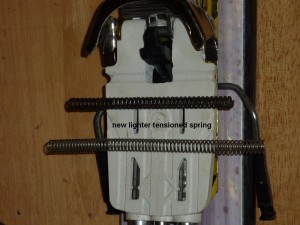
Here's the spring I chose. It's 2 inches longer than the stock spring but much lighter and ¼ the rate of the stock spring.
If the center spring is removed completely, the binding doesn’t throw itself open to allow the boot to step into it, but is 100% free pivoting in tour mode if the de-tensioning holes are drilled correctly. Rather than eliminate the spring completely, I decided to try a few different replacement springs to allow the claw to spring open (with much less force now) when the chrome lever is up, yet still have a nearly free pivot tour mode in the new de-tensioned position when the chrome lever is down. (And the tour lever is up)
One of the slick things about NTN’s design is that the tensioning midpart has a little “shoe” on the bottom of it that engages the binding frame when the chrome lever is down so it takes the powertube cable tension off the arms of the tensioning midpart and rests it on the binding frame. It’s a pretty cool design. A second slot has to be precisely morticed in the frame to receive this “shoe” in the new position of the midpart or the throw lever won’t depress completely.
I was working with Version 1 bindings. They are nice because the center pivot is removeable and it allowed me to repair the v1 toe stops. I had 3 extra v1 stops that I filled with solid white oak and applied glass resin to the ends of to keep water out. The modified toe stops are not going to break.
So far, I have made 2 pair of these modified bindings and haven’t got them out on the snow yet. I am working on my house and my shop,.. and actual paying jobs (Hurray!), but I have a few local friends who also ski NTN who are the designated guinnea pigs. I hope they will give the modified binding a try and provide some feedback on the modification’s performance. One skier is Marcus, who has the TTS system, so his review will be critically awaited. Mike (MD2020) has also been extended the offer and is another local NTN skier I am friends with. Lastly is Randy, who is also a friend who skis NTN, who will be offered the chance to test the new tour mode too, if he promises not to huck them. Randy also has NTbulldogs, so his review will also be a valuable comparison of those two binding’s tour modes.
Really there’s only one more thing to do to this incarnation of NTN, and that’s to skeletonize it on the drill press to remove weight. I plan on taking one of these pairs and removing at least ¾ lb. for the pair, so the pair will weigh under 4 lbs. I think I will be able to do this easily. I am also thinking of replacing the “snow catcher” NTN heel piece with one of the more common, lightweight, streamlined 2 wire heel pieces.
Here’s the completed modified NTN with all the modifications I’ve done to it as noted.
The final modified binding has steel threaded inserts for the set screws, reinforced toe stops, the frame is cut in 2 pieces and relinked with a bicycle master link, the center spring is replaced, and the tour mode is modified to be free pivoting. I call it the “bulletproof NTN” since it addresses and corrects all the warrantied defects of NTN since it’s debut.
**** There are 2 significant things to mention:
1) These modifications will void your warranty with Rottefella
2) The changed center spring may effect the release function when returning the binding to normal position ski mode (thanks bambi for pointing that out).
FINALLY: On Snow Testing
What can I say — it worked flawlessly. It took me a total of 10 seconds per ski to switch each ski back from the modified tour mode to the normal ski mode. I didn’t climb a very steep hill, but the modified tour mode felt 100% free pivoting to me. It’s a vast improvement over the standard NTN tour mode. It’s not an easy modification to make to the binding, and I don’t see myself doing it for people who have already spent $300+ dollars on a binding when it would void their manufacturer’s warranty, but it does show that there’s more room for improvement in the NTN system, and hopefully the system will get lighter and more free pivoting straight from the factory while retaining all of it’s present features, and also skiing as well as it undeniably does.
© 2011

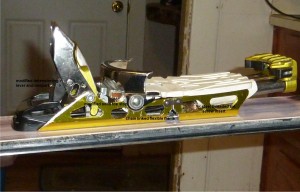
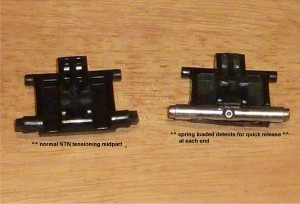
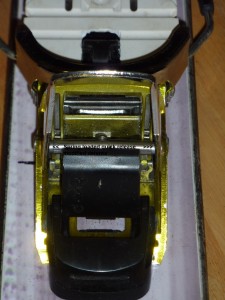
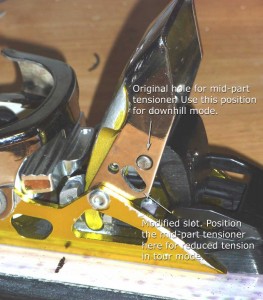
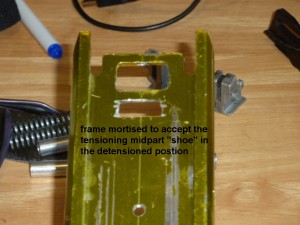
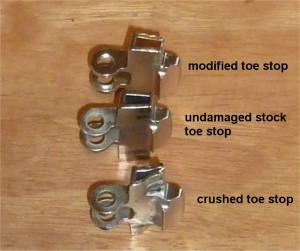
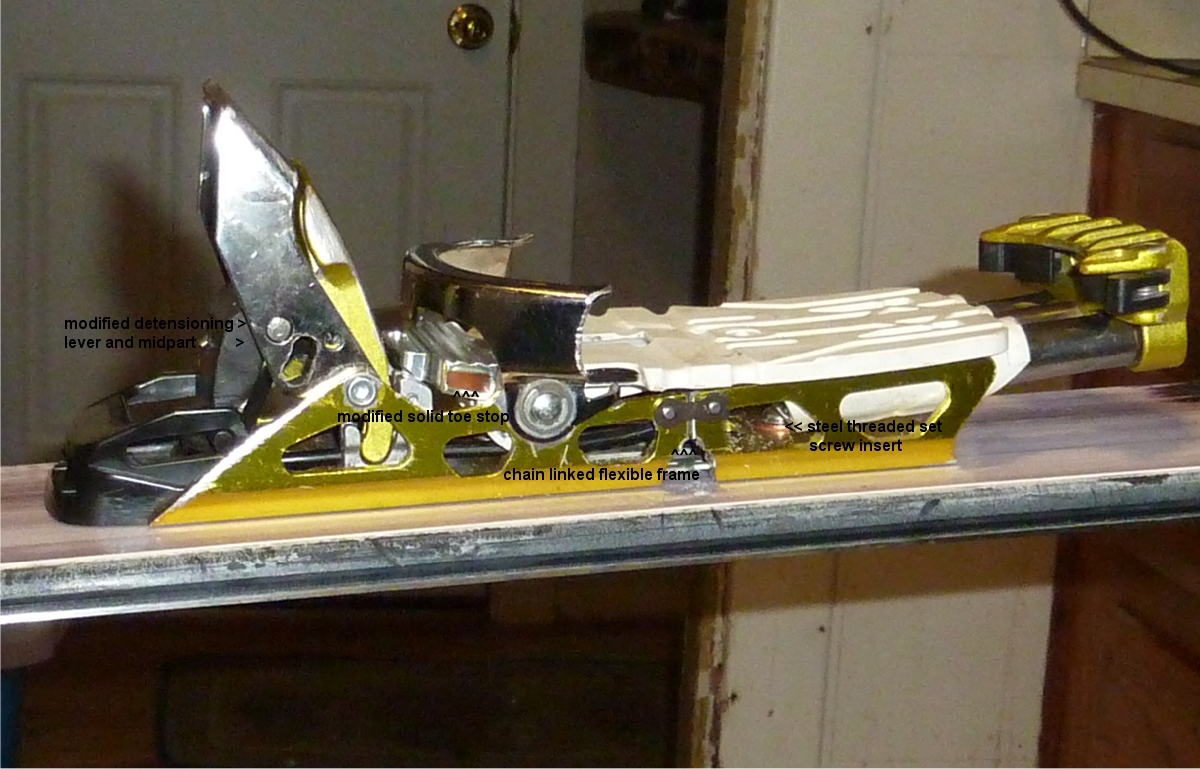
11 comments
Skip to comment form
Good work Tele.Skier !
As I was reading this I was struck by admiration for your efforts and frustrations with NTN. The fact you are forced to modify it to get a larger pivot range and reduced tension not to mention weight hurts!
I think the future (if there is one) for tele is clearly in the TTS system. I hope your pal will lend you some of that gear to get you going on mods that I think will bring tele the essentials: touring range, lightness, control; and, the nice to haves – step-in, release, heel lock compatibility.
Again, not hacking on your work – it’s super clever. That I admire. It’s just the NTN I can’t head down.
Joe
Author
Thanks Joe, I did NOT modify the binding to increase the free pivot range of motion btw. The binding boot interface of NTN is good in many ways. I feel someone is going to come along and make a better binding for the new standard once the underfoot claw patent expires.
TTS ….. that’s wishful thinking. I really look forward to seeing it in action, but my mechanical experience tells me it can’t withstand the torsional forces in it’s present simplistic form, but perhaps it will evolve too while remaining lightweight and free pivoting….
Thanks for correcting me about the range of motion. My bad.
I agree that the TTS in its current form is limited, but if folks look to using the second heel (duck butt) on the NTN boot we might go somewhere. As for the patent side of things, I wonder how locked up the use of the duck butt is. Black Diamond was part of the developers group who came up the overall concept but they bailed so do they kinda own the duck butt too?. Is a binding that engages the duck butt in patent violation even if it has a completely different approach than NTN?
If nothing else hopefully they won’t chase down garage tinkering. I may try to give the TTS modification a whirl.
Speaking of whirls… this usually where I chase Craig for his non-committal response on the Dostinator…
Author
From what I know about the duckbutt patents, (which is just hearsay) rottefella owns any use of that feature in any binding marketed for sale. It’s also my understanding that I could make a duckbutt binding of my own for myself if I wanted to without any patent infringement. The infringement would be selling a product using their patented design.
As far as them coming after me, I haven’t made a new binding, nor am I selling anything. I am not even modifying bindings for people because if I did that I would need liability insureance and probably the protection of incorporation so I don’t lose my house to the first guy who breaks his leg.
I made this tour modification because I purchased my first NTN off ebay and couldn’t warrantee them when the threads stripped. I found the steel inserts and made them work. Then one of the frames was bent in a fall, (I assumed) so I came up with the bicycle linked flexible frame to flex with the ski. At that point I was skiing frankenstein’s monster anyway so when I heard Rottefella didn’t attempt to improve the touring function in this years version, I felt like I could sacrifice a pair of bindings in an attempt to suit my own needs. Other NTN skiers contributed enough parts to my efforts that I didn’t actually lose a working set of bindings in my experiments.
On saturday, the bulletproof NTN’s get their maiden run skinning on muir snowfield. I hope to report good results
I’m not an engineer but it seems to me that almost all of the torsional forces in a Dynafit tech type AT binding are contained in the toe piece. The two pins that engage the heel are quite close to each other and really only grip the boot by pinching inwards on the metal plate screwed into the heel. In tour mode. ALL of the torsion is contained in the toe piece, locking out the release eliminates pre release. Having skied the TTS only a few days, I can attest that it seems to work just fine, but I can’t attest to durability.
Author
I don’t doubt TTS will work. I just think that my 6’2″+ 210lbs of hard charging force will make short work of an interface that is linear and the force is being applied at 90 degrees to the binding’s sprung direction of force. In essence my mondo size 30.5 boot is a 13 inch lever applying force perpendicular to the resisting force. The binding in my opinion needs lateral support (if the heel cable is not supplying it somehow) I have yet to see anyone ski it. I am sure I will this year, but in the interest of honesty, I wish to express my skepticism in the light of those who may be quick to embrace the design prematurely.
@ Teleskier and others looking at TTS:
I’m the same size as teleskier, and though I can’t comment on his ski ability, I am a hard charger and I ski low. I have been using TTS setups based on the Axl and more recently the Hammerhead. I have skied them hard on firm snow, bumps, high speed carving, running gates, and have had zero problems with pre-release, zero problems with exceeding ROM, and lateral stability is as good as any other ski binding outside of an alpine binding.
It’s admirable that you modified an NTN binding, I went that way myself not too long ago, but as you probably found, the NTN binding needs a complete makeover to be all it can be. Possibly the new Rotte NTN binding will meet your expectations, possibly not.
In the meantime, I’d suggest you ignore your skepticism and put some effort toward building your own TTS. As Joe and Derrell suggest, tech bindings are a lot more than they appear.
Consider this: When NTN removed the duckbill, they lost lateral stability in the toe.
If you examine the interface of an NTN toe and NTN toe bar, you’ll notice that this is not a stable relationship and is prone to slippage, hence the use of a overbuilt second heel to counter this loss of stability. By swapping out the NTN toe bar for two pins/sockets you regain significant lateral control as well as a means to retain the boot without a heel or second heel.
Once you go TTS, you won’t go back.
Watch for round two of my TTS tinkering: HH TTS 🙂
This has been an interesting read for me. It makes me wonder if Dynafit will come out with their own version of this as there are multiple boots they can interface with, w/o engaging what you all are calling the duck butt. If it were not for the NTN, this TTS would not have happened, though if NTN disappears, hopefully one binding mfg can pick these ideas up and make something stick. Tele is not for everyone, and will never be, though it will be interesting to see how many people would pick it up if the technology merges into a one quiver idea with a locking heel, kind of like the FrankenTele, but much lighter!
tele.skier,
Y’all just gotta “believe” before you can “see” that TTS will work for you. Otherwise… Besides, TTS is still a work in progress and if you can save the functionality of the NTN Freeride (theoretically finalized), think how much LESS work you might need to invest to optimize TTS? Or is that not enough challenge for you?
Ah some musing…
Since the NTN thing was invented, I’ve happily worn out three pairs of boots and free pivots (though weighty…).But fewer teleskiers means less demand and work shop innovations may be what saves the sport as it did with plastic cuffs innovations, which jump started plastic boots….and yes later, the AT surge.(Gee thanks telekskiers! Its hard to explain.)
Something will click in the tele binding world. It took us forever to add free pivot (Gee thanks AT skiers!). We have experience with the “duh” phases in our long history (and painful!)Ode to the few, the knee-benders and innovators with man-caves and tools.
Again a tele binding with optional lock down heels so we can alpine turn when needed. Just a little switch attached to the heel you punch with a pole. I see it my dreams. Tele skiers who abandoned(sic) the sport since the AT evolution might bite at such a versatile binding on those sick powder days when it’s too deep to have two tips forward. 😉
Dostie,
The Freeride has been completely superceded as a touring binding by the Freedom binding. My modified bindings don’t tour as well as the Freedoms simply because my modified Freeride’s don’t have as good of a range of motion and are heavier than the NTN Freedom’s. The actual resistance in tour mode is about the same for both bindings (my modified and the Freedom’s) because Rottefella also reduced the
tension of the spring that throws opens the Freedom binding (as did I in my modified binding) which also reduces the force resisting the boot in tour mode to almost zero.
The Freedom is excellent (although one of my bindings broke skiing in-bounds when the elastomer popped out). After getting replacement bindings, I’ve had no issues since and I am really loving the NTN Freedom binding. I installed inserts in both pairs of my dedicated touring skis so I can remove or add the brakes for touring or resort skiing and I can also move the One pair of bindings from my winter
touring skis to my summer skis and have one less binding to buy… I am really happy with the NTN Freedom so far.
The only thing I didn’t like about the NTN Freedom is the binding’s ramp angle. Since I like my boot cuff locked in the most upright position, the ramp angle of the binding put my hips in the “back seat” position. I cured it by adding a 3/16th shim under the heel and now the Freedom feels just like the Freeride. With my boot cuffs locked in the most upright position, I have a tall neutral stance with my hips in a well centered, slightly forward position.
I have said this before, but I will say it again. I love how the
underfoot connection of NTN skis. It feels different than a heel connected tele binding and it fits my technique well. It doesn’t feel like a pogo stick spring connected to my heel. I feel like I ride the whole ski, more than drive the ski tips around with binding leverage.
There’s a lot of people working on TTS. I don’t think that I will eclipse the years of effort that other people put into developing and testing different TTS configurations. I am just not interested in any heel connections…free the heel!
I applaud those who’s passion for better gear drives them to pursue it through their own efforts, but sometimes the manufacturer gets it right. In my opinion the function of NTN Freedom is right. The only thing it has yet to prove is durability which is always more of a distance event than a sprint.